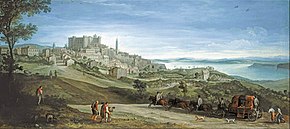Veduta

Aveduta(Italianfor 'view';pl.:vedute) is a highly detailed, usually large-scalepaintingor, more often,printof acityscapeor some other vista. The painters ofveduteare referred to asvedutisti.
Origins
[edit]
Thisgenreoflandscapeoriginated inFlanders,where artists such asPaul Brilpaintedveduteas early as the 16th century. In the 17th century, Dutch painters made a specialty of detailed and accurate recognizable city and landscapes that appealed to the sense of local pride of the wealthy Dutch middle class. An archetypal example isJohannes Vermeer'sView of Delft.TheGhentarchitect, draughtsman and engraverLieven Cruyl(1640–1720) contributed to the development of theveduteduring his residence in Rome in the late 17th century. Cruyl's drawings reproduce the topographical aspects of the urban landscape.[1]
18th century
[edit]As the itinerary of theGrand Tourbecame somewhat standardized,veduteof familiar scenes like theRoman Forumor theGrand Canalrecalled early ventures to the Continent for aristocratic Englishmen. By the mid-18th century,Venicebecame renowned as the centre of thevedutisti.The genre was pioneered byLuca Carlevarijs,and its greatest practitioners belonged to the Canal andGuardifamilies of Venice. Some of them went to work as painters in major capitals of Europe, e.g.,CanalettoinLondonand his nephewBernardo BellottoinDresdenandWarsaw.

In other parts of 18th-century Italy, idiosyncratic varieties of the genre evolved.Giovanni Paolo Panniniwas the firstvedutaartist to concentrate on paintingruins.The Dutch painterGaspar van Wittel(who worked in Rome, where he was known as Vanvitelli) and others paintedveduta esatta,i.e. exactvedute,which was a topographically accurate depiction of a cityscape or monument and in which the human and animal figures played a secondary role.[2]His collaborators includedHendrik Frans van Lint,who would become one of the leadingvedutepainters in the first half of the 18th century.[3]Through his more realistic representation in thevedutehe executed at the end of the 17th century and beginning of the 18th century, the Flemish painterJan Frans van Bloemenanticipated developments during the 18th century, when there was a shift away from the classically oriented Roman landscapes of Frenchvedutepainters in Rome such asGaspard Dughet.[4]

In later developments of thevedute,Pannini'svedutamorphed into the scenes partly or completely imaginary elements, known ascapricciandvedute ideateorveduta di fantasia.[2]Giambattista Piranesiwas the foremost master ofvedute ideateetchings.His topographical series,Vedute di Roma,went through many printings.
19th century
[edit]In the later 19th century, more personal "impressions" of cityscapes replaced the desire for topographical accuracy, which was satisfied instead by painted, and later photographed,panoramas.There was a sizeable community of émigré artists active in Venice, such asAntonietta Brandeis,the Spanish paintersMartín Rico y Ortega,Mariano Fortuny,Antonio Reyna ManescauandRafael Senetand the Peruvian painterFederico del Campo.These artists responded to the large international market for their city views of Venice, and they made such big names for themselves through this genre that they painted nothing but Italian views.

Demand for Federico del Campo's views, particularly from English tourists, was so strong that he painted several views multiple times,[5]and the same can be said of Reyna Manescau, that repeated the same urban landscapes in many occasions with minimal variations.[6]
See also
[edit]References
[edit]- ^Lieven Cruyl's veduti (or city views)
- ^abRudolf Wittkower,Art and architecture in Italy: 1600-1750,Penguin Books, 1980, p. 501
- ^Edgar Peters Bowron,Joseph J. Rishel,Art in Rome in the Eighteenth Century,Philadelphia Museum of Art; Museum of Fine Arts, Houston, 2000, p. 336-338
- ^Christine van Mulders and Alain Jacobs. "Bloemen, van." Grove Art Online. Oxford Art Online. Oxford University Press. Web. 5 Dec. 2014
- ^Federico del Campo, Peruvian, Gondolas by the Doge's Palace, Veniceat Sotheby's
- ^"Museo Carmen Thyssen Málaga".www.carmenthyssenmalaga.org(in Spanish).Retrieved2018-11-20.
Further reading
[edit]- Salerno, Luigi.(1991)I pittori di *Canaletto,a full text exhibition catalog from The Metropolitan Museum of Art, which has material on Canaletto's contributions to the genre
External links
[edit] Media related toVedutaat Wikimedia Commons
Media related toVedutaat Wikimedia Commons
